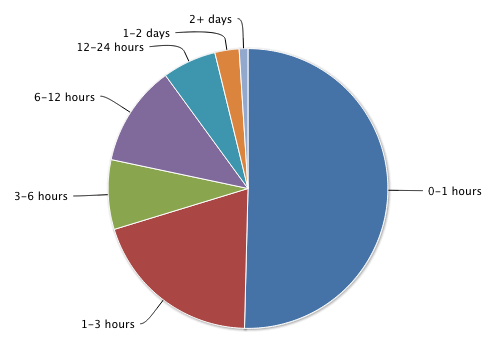Use the happiness advantage
June 10, 2012starting up

Looking back to the start of Buffer, one of the things I think may have helped a lot with gaining traction fast was to involve users in the validation process and tell these people how crucial their feedback would be. There are a few different things involved, but overall the best way to describe it was to simply make them happy.
Now as we move forward in a slightly later stage of the startup where we have hundreds of thousands of users instead of just hundreds, and we’re really trying to perfect the product and drive massive growth instead of being in a validation phase, we’ve actually also switched back to a focus on making users happy.
What is the happiness advantage?
In the simplest terms, the happiness advantage I am describing is giving the users a real feeling of surprise and happiness through the product and the service provided. Mark MacLeod, the former CFO of Tungle and Shopify, described it very well in his talk on SaaS Math:
"You really need to shower your users with love. People buy technology from startups for one of two reasons. One, it’s technology that they can’t get anywhere else, or two it’s a level of service and support and love that they can’t get anywhere else. The startups that do really well and take off have showered their users with love. You send a request to support and you hear back right away. They’ve got a very active blog and they build a community. Every time an executive goes to a different city they’re having dinners for the users in that city. They’re building massive loyalty and those users are going out and becoming ambassadors and helping recruit more users."
Why use the happiness advantage?
Of course, giving this much attention to people who use your product does take extra work. It also takes a whole new mindset to genuinely appreciate every contact from users, and to cherish the conversation no matter whether they are delighted, confused or complaining. I truly believe, however, that this extra work is worth it in so many ways. Here are some of the benefits we’ve seen:
Early stage benefits
In the earliest stages, you very likely have a product you’re embarrassed about, but you’ve pushed it live anyway because you know how important it is to learn quickly whether your assumptions are correct.
There are many things against you, but the great thing is that you aren’t flooded with support emails and you don’t have many users. Therefore you can be in touch with all of your users individually, and you can not only learn a massive amount from them about the next steps for the product, but you can have a profound impact on them and make them true ambassadors of your product and brand. They can be your best friends.
What’s even better is that these first few users crave this involvement and know that the product won’t be perfect. As Leo has put it, the first users are a different breed, and you want to know them.
Later stage benefits
As Buffer has grown, we’ve tried many different things to try and continue to improve the rate of our growth. After trying many different things, we’ve eventually come back to using the happiness advantage as our key driver of growth. Marketing directly can’t compare to simply having users who love to tell others about the product. With this approach, we have a multiplication effect.
One of our biggest inspirations for a lot of the ways we approach things is Evernote. I believe they use the happiness advantage to great effect. Here’s how they describe their approach:
"The job of getting someone whos never heard of Evernote to use it for the first time is the job of our existing users. The job of our marketing department is to help our existing users do that job." - Phil Libin, Evernote
How we are doing it at Buffer
In the last few weeks at Buffer, we’ve been working hard on making use of the happiness advantage even at a larger scale now. We get over 100 emails per day, but we’re determined to answer them all swiftly and not only that but solve their problems and make improvements to the product as a result of the conversations we have.
For the last few weeks, we’ve worked hard at this new focus. Leo and Alyssa especially have done a fantastic job. We’ve now managed to achieve 50% of emails being answered within 1 hour, and 77% within 6 hours:

(The chart above is from the Reports feature inside Help Scout. It’s an awesome product and we certainly couldn’t do as good email support without them)
We are also starting to receive a lot of very positive Tweets about the experience from users, such as this great Tweet from Marci:
When I had an issue w/ @bufferapp 2day the co-founder personally helped me solve it!Great support. @tweetdeck…still waiting!
Marci Liroff (@marciliroff) June 7, 2012
It’s Tweets like this which confirm in my mind what Mark MacLeod says about users becoming ambassadors.
On Thursday, Leo, Alyssa and I had a great brainstorm about changes we can make this week to move this to 60% within 1 hour and 90% within 6 hours. We’ve made some adjustments to when we will do support emails and even to our sleeping habits to achieve this. I’m very excited about the impact we can have with this.
It involves the product too
In this article, I’ve tried to stay very focused on how interactions with users can provide massive benefits, and how focusing on making people happy can turn them into ambassadors. One thing that’s definitely important to mention alongside this discussion is that I definitely believe the quality of the product plays a key role too.
Not only is it important to have a great product that people are eager to share with others, it is also vital that when people have interactions with you and you tell them that you’re working on improving something, they need to see those improvements happen. This is what inspires confidence and creates long-lasting loyalty.
For this reason, at Buffer, we have just two focuses: making users happy (wowing them) and building an awesome product (with an aha moment). To ensure these two things are bound together, we all have input into the product development, and we all do support at some point every week.
Are you using the happiness advantage?
Photo credit: Chapendra
